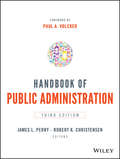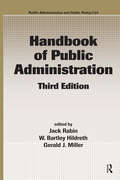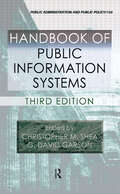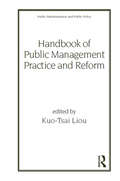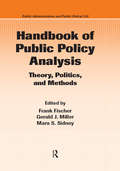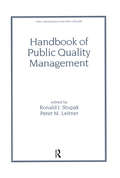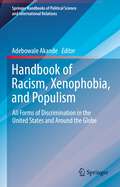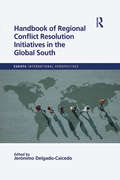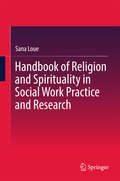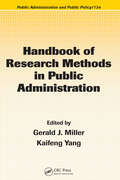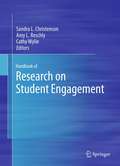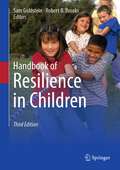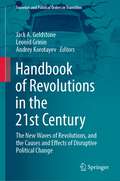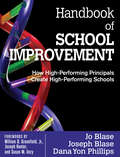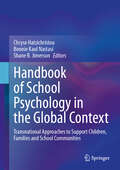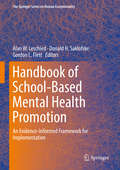- Table View
- List View
Handbook of Political Islam in Europe: Activities, Means, and Strategies from Salafists to the Muslim Brotherhood and Beyond (Springer Handbooks of Political Science and International Relations)
by Thomas Jäger Ralph ThieleThis book approaches the field of Political Islam from a European security perspective. Featuring various case studies and country surveys written by respected experts in the field, it offers a comparative perspective and comprehensive overview of the ideology and prevalence of Political Islam and its actors in more than 20 European states. The respective contributions identify key actors of Political Islam and reveal the activities, means, and strategies they pursue and employ across the continent. They also discuss if and how Political Islam could undermine the Western liberal democratic order and its associated values. By doing so, the volume offers approaches to analyzing Political Islam and thereby strengthening the resilience of liberal democratic societies, while also protecting Muslims from the radical ideology and agenda of Political Islam.Chapter - "Hybridizing Islam in the Balkans: The Rise of Salafi-Hanafism in Bulgaria" is licensed under the terms of the Creative Commons Attribution 4.0 International License (http://creativecommons.org/licenses/by/4.0/). For further details see license information in the chapter.
Handbook of Politics
by J. Craig Jenkins Kevin T. LeichtPolitical sociology is the interdisciplinary study of power and the intersection of personality, society and politics. The field also examines how the political process is affected by major social trends as well as exploring how social policies are altered by various social forces. Political sociologists increasingly use a wide variety of relatively new quantitative and qualitative methodologies and incorporate theories and research from other social science cognate disciplines. The contributors focus on the current controversies and disagreements surrounding the use of different methodologies for the study of politics and society, and discussions of specific applications found in the widely scattered literature where substantive research in the field is published. This approach will solidly place the handbook in a market niche that is not occupied by the current volumes while also covering many of the same theoretical and historical developments that the other volumes cover. The purpose of this handbook is to summarize state-of-the-art theory, research, and methods used in the study of politics and society. This area of research encompasses a wide variety of perspectives and methods that span social science disciplines. The handbook is designed to reflect that diversity in content, method and focus. In addition, it will cover developments in the developed and underdeveloped worlds.
Handbook of Professional Development in Education: Successful Models and Practices, PreK-12
by Diana J. Quatroche Andy Hargreaves Sherry Kragler Kathryn L. Bauserman Linda E. MartinSynthesizing the best current knowledge on teacher professional development (PD), this handbook describes effective, innovative practices that are being used in schools today. Leading authorities present PD approaches that are instructive, reflective, active, collaborative, and substantive. The book explores the relationship of PD to adult learning theory, school leadership, district and state policy, the growth of professional learning communities, and the Common Core State Standards. Practical issues in implementing PD are addressed, as are strategies for measuring and sustaining successful programs. Each chapter concludes with thought-provoking discussion questions. The appendix provides eight illuminating case studies of PD initiatives in diverse schools.
Handbook of Public Administration
by Robert K. Christensen James L. PerryThe fundamentals of public administration, from the world's leading practitionersHandbook of Public Administration is the classic, comprehensive guide to the field, featuring original writings from the world's foremost public administration thought leaders and practitioners. Intended to help both public administration students and practitioners navigate administrative challenges, overcome obstacles, and improve effectiveness, this guide provides a complete overview of the entire field. The information is organized into seven parts representing key domains of knowledge and practice that are essential for effective public administration. These reflect changes in the state of modern public administration, the factors that influence policies and programs, the mechanics of how government works, and the tools that help administrators get things done. Readers will find insightful discussions on the challenges of contemporary governance and the ethics of public administration, as well as practical guidance on the everyday operations that bring effective policies and programs to life.Students and experienced practitioners alike will appreciate the well-rounded approach to issues public administrators face every day. The book is complete enough to act as a text, but organized logically for quick reference for specific problems or situations. Readers will:Understand the challenges posed by the changing context of public administrationExplore how relationships and decisions influence public policies and programsLearn the critical skills and tools public administrators must master to be effectiveExplore the ethics and liabilities of public administration, and what it means to take partThe role of public administration is evolving, and the changing nature of the field will impact the way policies and programs are designed and implemented. This book fully explores current and upcoming changes domestically and internationally against the backdrop of public administration fundamentals. For the student or professional seeking a deeper understanding of the public administrator's role, Handbook of Public Administration is a clear, comprehensive resource.
Handbook of Public Administration: Theory, Politics, And Methods (Public Administration and Public Policy #1)
by Gerald J. Miller W. Bartley Hildreth Evert A. LindquistPublic administration as a field of study finds itself in the middle of a fluid environment. The very reach and complexity of public administration has been easy to take for granted, easy to attack, and difficult to explain, particularly in the soundbite and Twitter-snipe media environment. Not only has the context for the discipline changed, but the institutions of public administration have adapted and innovated to deliver services to the public and serve those in power while becoming increasingly complex themselves. Has public administration evolved? And what new lines of research are critical for effective policy and delivery of programs and public services while preserving foundational principles such as the rule of law and expert institutions? This Handbook of Public Administration sheds light for new researchers, doctoral students, scholars, and practitioners interested in probing modern public administration’s role in solving major challenges facing nations and the world. This fourth edition recognizes that the scholarship of public administration must reflect the diverse influence of an international orientation, embracing public administration issues and practices in governance systems around the world, and illustrating just how practice can vary across jurisdictions. Every section identifies foundational principles and issues, shows variation in practice across selected jurisdictions, and identifies promising avenues for research. Each chapter revisits enduring themes and tensions, showing how they persist, along with new challenges and opportunities presented by digital technology and contemporary political realities. The Handbook of Public Administration, Fourth Edition provides a compelling introduction to and depiction of the contemporary realities of public administration, and it will inspire new avenues of inquiry for the next generation of public administration researchers.
Handbook of Public Administration: Theory, Politics, And Methods (Public Administration and Public Policy #1)
by Gerald J. Miller W. Bartley Hildreth Evert A. LindquistPublic administration as a field of study finds itself in the middle of a fluid environment. The very reach and complexity of public administration has been easy to take for granted, easy to attack, and difficult to explain, particularly in the soundbite and Twitter-snipe media environment. Not only has the context for the discipline changed, but the institutions of public administration have adapted and innovated to deliver services to the public and serve those in power while becoming increasingly complex themselves. Has public administration evolved? And what new lines of research are critical for effective policy and delivery of programs and public services while preserving foundational principles such as the rule of law and expert institutions? This Handbook of Public Administration sheds light for new researchers, doctoral students, scholars, and practitioners interested in probing modern public administration’s role in solving major challenges facing nations and the world. This fourth edition recognizes that the scholarship of public administration must reflect the diverse influence of an international orientation, embracing public administration issues and practices in governance systems around the world, and illustrating just how practice can vary across jurisdictions. Every section identifies foundational principles and issues, shows variation in practice across selected jurisdictions, and identifies promising avenues for research. Each chapter revisits enduring themes and tensions, showing how they persist, along with new challenges and opportunities presented by digital technology and contemporary political realities. The Handbook of Public Administration, Fourth Edition provides a compelling introduction to and depiction of the contemporary realities of public administration, and it will inspire new avenues of inquiry for the next generation of public administration researchers.
Handbook of Public Administration: Theory, Politics, And Methods (Public Administration and Public Policy #1)
by Gerald J. Miller Jack Rabin W. Bartley HildrethSince the publication of the previous edition, the best-selling Handbook of Public Administration enters its third edition with substantially revised, updated, and expanded coverage of public administration history, theory, and practice. Edited by preeminent authorities in the field, this work is unparalleled in its thorough coverage and comprehensive references. This handbook examines the major areas in public administration including public budgeting and financial management, human resourcemanagement, decision making, public law and regulation, and political economy. Providing a strong platform for further research and advancement in the field, this book is a necessity for anyone involved in public administration, policy, and management. This edition includes entirely new chapters on information technology and conduct of inquiry. In each area of public administration, there are two bibliographic treatises written from different perspectives. The first examines the developments in the field. The second analyzes theories, concepts, or ideas in the field’s literature.
Handbook of Public Information Systems (Public Administration and Public Policy)
by Alison Kelly Judith GrahamDelivering IT projects on time and within budget, while maintaining privacy, security, and accountability, remains one of the major public challenges of our time. In the four short years since the publication of the second edition of the Handbook of Public Information Systems, the field of public information systems has continued to evolve. This ev
Handbook of Public Management Practice and Reform (Public Administration and Public Policy)
by Kuotsai Tom LiouOutlining the origins, motivations, strategies, implementations, and effectiveness of reform policies and programs, Handbook of Public Management Practice and Reform examines changes and challenges in major areas of public administration, including budgeting, finance, human resources, and organizational management, reviews the lessons of reform, and addresses new ideas and emerging issues. Discussing the development and contribution of public administration education, research, and professional associations, the book covers decentralization and deregulation, institutional arrangement and support, and cooperation between public and nonprofit organizations.
Handbook of Public Policy Analysis: Theory, Politics, and Methods (Public Administration and Public Policy)
by Frank Fischer Gerald J. MillerThe study of public policy and the methods of policy analysis are among the most rapidly developing areas in the social sciences. Policy analysis has emerged to provide a better understanding of the policymaking process and to supply decision makers with reliable policy-relevant knowledge about pressing economic and social problems. Presenting a broad, comprehensive perspective, the Handbook of Public Policy Analysis: Theory, Politics, and Methods covers the historical development of policy analysis, its role in the policy process, and empirical methods. The handbook considers the theory generated by these methods and the normative and ethical issues surrounding their practice.Written by leading experts in the field, this book-Deals with the basic origins and evolution of public policy Examines the stages of the policy-making processIdentifies political advocacy and expertise in the policy processFocuses on rationality in policy decision-making and the role of policy networks and learningDetails argumentation, rhetoric, and narratives Explores the comparative, cultural, and ethical aspects of public policy Explains primary quantitative-oriented analytical methods employed in policy researchAddresses the qualitative sides of policy analysis Discusses tools used to refine policy choicesTraces the development of policy analysis in selected national contextsThe Handbook of Public Policy Analysis: Theory, Politics, and Methods describes the theoretical debates that have recently defined the field, including the work of postpositivist, interpretivist, and social constructionist scholars. This book also explores the interplay between empirical and normative analysis, a crucial issue running through contemporary debates.
Handbook of Public Quality Management (Public Administration and Public Policy)
by Ronald J. Stupak Peter M. LeitnerExploring a variety of methods for improving the economic performance of organizations, this multidisciplinary text covers macro- and micro-perspectives while considering strategic planning, systematic process analysis, leadership studies, group dynamics, and human motivation theories. It highlights "quality of relationships" as a guiding principle within the framework of public administration and stresses customer, client, and stakeholder satisfaction. With over 1000 literature references, tables, drawings, and equations, and appendices of laws and regulations, the book responds to the mandate for high performance and increased productivity.
Handbook of Public Sector Economics (Public Administration and Public Policy)
by Donijo RobbinsThe Handbook of Public Sector Economics builds an understanding of the role of public economics in public administration, public policy, and decision making. The handbook introduces a wide variety of current issues related to the public provision and production of goods and services.The volume documents the history of economics and fiscal doctrine, explores the theory of public goods and the structures from which resources are collected and expanded, and analyzes heavily debated issues of economics that are important to current and future practitioners of public policy and administration. It focuses on the effects of fiscal policy on savings and investment, consumer behavior, labor supply, wealth, property, and trade. Written in a simple and straightforward style, the initial chapters establish the foundation of public economics, with the subsequent chapters addressing the collection and distribution of government resources and market reactions to fiscal policies.
Handbook of Racism, Xenophobia, and Populism: All Forms of Discrimination in the United States and Around the Globe (Springer Handbooks of Political Science and International Relations)
by Adebowale AkandeThis handbook presents the roots of symbolic racism as partly in both anti-black antagonism and non-racial conservative attitudes and values, representing a new form of racism independent of older racial and political attitudes. By doing so, it homes in on certain historical incidents and episodes and presents a cogent analysis of anti-black, Jim Crowism, anti-people of color (Black, Latino, Native Americans), and prejudice that exists in the United States and around the world as a central tenet of racism. The book exposes the reader to the nature and practice of stereotyping, negative bias, social categorization, modern forms of racism, immigration law empowerment, racialized incarceration, and police brutality in the American heartland. It states that several centuries of white Americans’ negative socializing culture marked by widespread negative attitudes toward African Americans, are not eradicated and are still rife. Further, the book provides a panoramic view of trends of racial discrimination and other negative and desperate challenges that Black, Indigenous, and People of Color face across the world. Finally, the volume examines xenophobia, racism, prejudice, and stereotyping in different contexts, including topics such as Covid-19, religion and racism, information manipulation, and populism. The book, therefore, is a must-read for students, researchers, and scholars of political science, psychology, history, sociology, communications/media studies, diplomatic studies, and law in general, as well as ethnic and racial studies, American politics, global affairs, populism, and discrimination in particular.
Handbook of Regional Conflict Resolution Initiatives in the Global South (Europa International Perspectives)
by Jerónimo Delgado-CaicedoDuring the first half of the twentieth century, the international system was largely dominated by the USA and the colonial powers of western Europe. After the two world wars, the political and economic dominance of these states guaranteed them and their allies an almost complete control of world politics. However, as it is the norm in the international system, power structures are not immutable. After the end of the Cold War, rapid changes to the existing international hierarchies took place, as new countries from the so-called ‘‘developing world’’ began to emerge as crucial actors capable of questioning and altering the power dynamics of the world. It is therefore unthinkable to ignore emerging countries such as Russia, the People’s Republic of China, India, Brazil or South Africa in the decision-making process in today’s world order. In addition, there is a group of smaller, yet increasingly important countries that, while acknowledging their inability radically to change the rules of the international system, are still eager to shift power relations and enhance their influence in the world. Argentina, Colombia, Egypt, Indonesia, Iran, South Korea, Mexico, Nigeria, Pakistan, Saudi Arabia, Turkey and Vietnam are generally recognised as part of this grouping of emerging powers from the Global South. While there is a consensus amongst academics that emerging powers from the Global South must have a stabilising role within their own regions, previous analyses have focused primarily on the impact that emerging powers have had in their own regions’ conflict resolution initiatives. This volume, instead, aims to go beyond these analyses and provide new insights regarding the effect that this stabilising role has on the continental and global positioning of emerging powers. In other words, this book explores the relation between a country’s involvement in conflict resolution initiatives and its positioning in the international system. The volume will contribute to this approach using the perspective of academics and practitioners from countries of the Global South, particularly from states that have strengthened - or sometimes weakened - their position in the international hierarchy of power through a leading role in regional conflict resolution initiatives.
Handbook of Religion and Spirituality in Social Work Practice and Research
by Sana LoueThis singular reference explores religion and spirituality as a vital, though often misconstrued, lens for building better understanding of and empathy with clients. A diverse palette of faiths and traditions is compared and contrasted (occasionally with secularism), focusing on areas of belief that may inspire, comfort, or trouble clients, including health and illness, mental illness, healing, coping, forgiveness, family, inclusion, and death. From assessment and intervention planning to conducting research, these chapters guide professionals in supporting and assisting clients without minimizing or overstating their beliefs. In addition, the book's progression of ideas takes readers beyond the well-known concept of cultural competence to model a larger and more meaningful cultural safety. Among the topics included in the Handbook: Integrating religion and spirituality into social work practice. Cultural humility, cultural safety, and beyond: new understandings and implications for social work. Healing traditions, religion/spirituality, and health. Diagnosis: religious/spiritual experience or mental illness? Understandings of dying, death, and mourning. (Re)building bridges in and with family and community. Ethical issues in conducting research on religion and spirituality. The Handbook of Religion and Spirituality in Social Work Practice and Research is a richly-textured resource for social workers and mental health professionals engaged in clinical practice and/or research seeking to gain varied perspectives on how the religion and spirituality of their clients/research participants may inform their work.
Handbook of Research Methods in Public Administration (Public Administration and Public Policy)
by Sondra Brandler Camille P. RomanDescribing new techniques and novel applications, Handbook of Research Methods in Public Administration, Second Edition demonstrates the use of tools designed to meet the increased complexity of problems in government and non-profit organizations with ever-more rigorous and systematic research. It presents detailed information on conceptuali
Handbook of Research in Education Finance and Policy
by Helen F. Ladd Margaret E. GoertzSponsored by the Association for Education Finance and Policy (AEFP), the second edition of this groundbreaking handbook assembles in one place the existing research-based knowledge in education finance and policy, with particular attention to elementary and secondary education. Chapters from the first edition have been fully updated and revised to reflect current developments, new policies, and recent research. With new chapters on teacher evaluation, alternatives to traditional public schooling, and cost-benefit analysis, this volume provides a readily available current resource for anyone involved in education finance and policy. The Handbook of Research in Education Finance and Policy traces the evolution of the field from its initial focus on school inputs and revenue sources used to finance these inputs, to a focus on educational outcomes and the larger policies used to achieve them. Chapters show how decision making in school finance inevitably interacts with decisions about governance, accountability, equity, privatization, and other areas of education policy. Because a full understanding of important contemporary issues requires inputs from a variety of perspectives, the Handbook draws on contributors from a number of disciplines. Although many of the chapters cover complex, state-of-the-art empirical research, the authors explain key concepts in language that non-specialists can understand. This comprehensive, balanced, and accessible resource provides a wealth of factual information, data, and wisdom to help educators improve the quality of education in the United States.
Handbook of Research on Student Engagement
by Cathy Wylie Amy L. Reschly Sandra L. ChristensonFor more than two decades, the concept of student engagement has grown from simple attention in class to a construct comprised of cognitive, emotional, and behavioral components that embody and further develop motivation for learning. Similarly, the goals of student engagement have evolved from dropout prevention to improved outcomes for lifelong learning. This robust expansion has led to numerous lines of research across disciplines and are brought together clearly and comprehensively in the Handbook of Research on Student Engagement. The Handbook guides readers through the field's rich history, sorts out its component constructs, and identifies knowledge gaps to be filled by future research. Grounding data in real-world learning situations, contributors analyze indicators and facilitators of student engagement, link engagement to motivation, and gauge the impact of family, peers, and teachers on engagement in elementary and secondary grades. Findings on the effectiveness of classroom interventions are discussed in detail. And because assessing engagement is still a relatively new endeavor, chapters on measurement methods and issues round out this important resource. Topical areas addressed in the Handbook include: Engagement across developmental stages.Self-efficacy in the engaged learner.Parental and social influences on engagement and achievement motivation.The engaging nature of teaching for competency development.The relationship between engagement and high-risk behavior in adolescents.Comparing methods for measuring student engagement.An essential guide to the expanding knowledge base, the Handbook of Research on Student Engagement serves as a valuable resource for researchers, scientist-practitioners, and graduate students in such varied fields as clinical child and school psychology, educational psychology, public health, teaching and teacher education, social work, and educational policy.
Handbook of Resilience in Children
by Sam Goldstein Robert B. BrooksThe third edition of this handbook addresses not only the concept of resilience in children who overcome adversity, but it also explores the development of children not considered at risk addressing recent challenges as a consequence of the COVID-19 pandemic. The new edition reviews the scientific literature that supports findings that stress-hardiness and resilience in all children leads to happier and healthier lives as well as improved functionality across the lifespan. In this edition, expert contributors examine resilience in relation to environmental stressors as phenomena in child and adolescent disorders and as a means toward positive adaptation into adulthood. The significantly expanded third edition includes new and significantly revised chapters that explore strategies for developing resilience in families, clinical practice, and educational settings as well as its nurturance in caregivers and teachers. Key areas of coverage include: Exploration of the four waves of resilience research. Resilience in gene-environment transactions. Resilience in boys and girls. Resilience in family processes. Asset building as an essential component of intervention. Assessment of social and emotional competencies related to resilience. Building resilience through school bullying prevention. Resilience in positive youth development. Enhancing resilience through effective thinking. The Handbook of Resilience in Children, Third Edition, is an essential reference for researchers, clinicians and allied practitioners, and graduate students across such interrelated disciplines as child and school psychology, social work, public health as well as developmental psychology, special and general education, child and adolescent psychiatry, family studies, and pediatrics.
Handbook of Revolutions in the 21st Century: The New Waves of Revolutions, and the Causes and Effects of Disruptive Political Change (Societies and Political Orders in Transition)
by Jack A. Goldstone Leonid Grinin Andrey KorotayevThe 21st century has witnessed a considerable and increasing number of political revolutions around the world. This contradicts the popular belief of many experts in the 1970s that revolutions occurred mainly in monarchies and empires. Instead, the revolutions of this century have several new characteristics, which call for a renewed analysis of the subject.This handbook offers a comparative perspective on the new wave of revolutions of the last decade. Presenting case studies on the color revolutions, the Arab revolutions of 2010–2011, and the global wave of revolutions in 2013–2018 that spanned regions ranging from Africa to the Caucasus, it offers a better understanding of the varied forms, features, and historical backgrounds of revolutions, as well as their causes. Accordingly, it highlights recent revolutions in their historical and world-systems contexts.The handbook is divided into seven parts, the first of which examines the history of views on revolution and important aspects of the theory of revolution. The second part analyzes revolutions within long-term historical trends and in their world-system contexts. In turn, the third part explores specific major revolutionary waves in history. The fourth part analyzes the first revolutionary wave of the 21st century (2000–2009), the so-called color revolutions, while the fifth discusses the second wave – the Arab Spring (2010–2013) – as an important turning point. The sixth part is dedicated to analyzing revolutions and revolutionary movements beyond the Arab Spring and some revolutionary events from the third wave that began in 2018. The seventh and final part offers forecasts on the future of revolutions. Given its scope, the book will appeal to scholars and students from various disciplines interested in historical trends, sociopolitical change, contentious politics, social movements, and revolutionary processes involving both nonviolent campaigns and political violence. "Once again, this volume demonstrates the kind of open-minded, systematic analysis that the field of revolutionary studies requires." (Prof. George Lawson, Department of International Relations, Australian National University Canberra)
Handbook of School Improvement: How High-Performing Principals Create High-Performing Schools
by Joseph Blase Rebajo R. Blase Dr Dana Yon PhillipsLearn how successful principals make a difference in their school’s performance! Based on a ground-breaking study and numerous firsthand accounts, this illuminating book captures unique perspectives from 20 outstanding principals, representing a wide range of urban and rural schools. This resource includes: <p><p> The nine personal characteristics that help principals lead high-performing schools <p> Practical strategies for balancing both administrative responsibilities and instructional leadership <p> Guidance on using a systems-development approach to support excellence at every level <p> Discussion of the use of research and data for school improvement <p> Tips and suggestions from effective principals, along with recommended resources for further learning
Handbook of School Mental Health: Research, Training, Practice, and Policy
by Mark D. Weist Julie Sarno Owens Catherine Bradshaw Nancy A. LeverWith so few therapeutic outlets readily available to young people, schools have evolved into mental health centers for many students. Yet schools are hampered by limited access to resources needed to provide mental health promotion, prevention, and intervention services. Like its acclaimed predecessor, the Second Edition of the Handbook of School Mental Health offers ways for professionals to maximize resources, make and strengthen valuable connections, and attain more effective school-based services and programming. At the same time, the Handbook provides strategies and recommendations in critical areas, such as workforce development, interdisciplinary collaborations, youth/family engagement, consultation, funding, and policy concerns, summarizes the state of current research, and offers directions for further study. Chapters model best practices for promoting wellness and safety, early detection of emotional and behavioral problems, and school-based interventions for students with anxiety, depression, attention deficit hyperactivity disorder, and other common challenges. In spotlighting this range of issues, the contributors have created a comprehensive game plan for advancing the field. Among the Handbook's topics: Pre-service training for school mental health clinicians.Cognitive-behavioral interventions for trauma in schools. Increasing parental engagement in school-based interventions.Models of psychiatric consultation to schools.Culturally competent behavioral and emotional screening. Bullying from a school mental health perspective.Prevention and intervention strategies related to a variety of mental health problems in schools. The Second Edition of the Handbook of School Mental Health is an essential reference for researchers, graduate students, and other professionals in child and school psychology, special and general education, public health, school nursing, occupational therapy, psychiatry, social work and counseling, educational policy, and family advocacy.
Handbook of School Psychology in the Global Context: Transnational Approaches to Support Children, Families and School Communities
by Shane R. Jimerson Bonnie Kaul Nastasi Chryse HatzichristouThis handbook introduces a transnational approach to school psychology theory and practice. It provides a detailed review and analysis of multicultural and international literature in school psychology. In addition, the volume synthesizes this literature in ways that help promote transnational perspectives in the field of school psychology and recommends transnational processes that can further enhance the preparation and the role of school psychologists across a global context. With contributions from school psychology faculty members, researchers, and practitioners across diverse, multicultural, and international backgrounds, this book offers readers interested in studying or practicing school psychology in a transnational context an excellent background and introduction to the subject matter. Topical coverage ranges from conceptual foundations, educational and psychosocial foundations/systems, psychological and educational assessment, prevention and intervention, international research projects, school psychological services and training, special topics and future directions in the field. The breadth of the chapters makes this handbook a key resources for guiding and directing future research, training and practice that considers the current transnational challenges and resources of school psychology. This handbook is an essential resource for researchers, scientist-practitioners, clinicians, and graduate students in child and school psychology, social work, public health, educational policy and politics, and other school-based and child-serving mental health disciplines.
Handbook of School-Based Mental Health Promotion: An Evidence-informed Framework For Implementation (The\springer Series On Human Exceptionality Ser.)
by Donald H. Saklofske Gordon L. Flett Alan W. LeschiedThe Springer Series on Human Exceptionality Series Editors: Donald H. Saklofske and Moshe Zeidner Handbook for School-Based Mental Health Promotion An Evidence-Informed Framework for Implementation Alan W. Leschied, Donald H. Saklofske, and Gordon L. Flett, Editors This handbook provides a comprehensive overview to implementing effective evidence-based mental health promotion in schools. It addresses issues surrounding the increasing demands on school psychologists and educational and mental health professionals to support and provide improved student well-being, learning, and academic outcomes. The volume explores factors outside the traditional framework of learning that are important in maximizing educational outcomes as well as how students learn to cope with emotional challenges that confront them both during their school years and across the lifespan. Chapters offer robust examples of successful programs and interventions, addressing a range of student issues, including depression, self-harm, social anxiety, high-achiever anxiety, and hidden distress. In addition, chapters explore ways in which mental health and education professionals can implement evidence-informed programs, from the testing and experimental stages to actual use within schools and classrooms. Topics featured in this handbook include: · A Canadian perspective to mental health literacy and teacher preparation. · The relevance of emotional intelligence in the effectiveness of delivering school-based mental health programs. · Intervention programs for reducing self-stigma in children and adolescents. · School-based suicide prevention and intervention. · Mindfulness-based programs in school settings. · Implementing emotional intelligence programs in Australian schools. The Handbook for School-Based Mental Health Promotion is a must-have resource for researchers, clinicians and related professionals, and policymakers as well as graduate students across such interrelated disciplines as child and school psychology, social work, education policy and politics, special and general education, public health, school nursing, occupational therapy, psychiatry, school counseling, and family studies.
Handbook of Security Science
by Anthony J. MasysThis handbook offers insights into how science (physical, natural and social) and technology can support new developments to manage the complexity resident within the threat and risk landscape.The security landscape can be described as dynamic and complex stemming from the emerging threats and risks that are both persistent and transborder. Globalization, climate change, terrorism, transnational crime can have significant societal impact and forces one to re-evaluate what ‘national security’ means. Recent global events such as mass migration, terrorist acts, pandemics and cyber threats highlight the inherent vulnerabilities in our current security posture. As an interdisciplinary body of work, the Handbook of Security Science captures concepts, theories and security science applications, thereby providing a survey of current and emerging trends in security. Through an evidence-based approach, the collection of chapters in the book delivers insightful and comprehensive articulation of the problem and solution space associated with the complex security landscape. In so doing the Handbook of Security Science introduces scientific tools and methodologies to inform security management, risk and resilience decision support systems; insights supporting design of security solutions; approaches to threat, risk and vulnerability analysis; articulation of advanced cyber security solutions; and current developments with respect to integrated computational and analytical solutions that increase our understanding of security physical, social, economic, and technological interrelationships and problem space.



